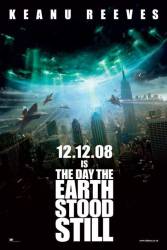Corrected entry: In an aerial shot of the car driving on a road through the countryside in New Jersey, there is one yellow line for not passing. It should be a double yellow line for a curved highway for no passing on either side.
Corrected entry: In any of the scenes when it is raining, the characters are wet, but rain is never actually hitting them. It's like the rain is falling in front of the camera and not on the actors. This is very obvious when Klaatu and Jacob are on the small bridge, right after Jacob is saved from falling in the water. Jacob is looking up at Klaatu, it's pouring outside, yet his face is completely dry. Also, in the long shot showing them on the bridge, the creek is running under the bridge, but no rain can be seen hitting the creek.
Correction: This isn'really true, in the scene on the samll bridge, you can see the raindrops hitting Klaatu and Jacob. Look at Klaatu's right shoulder.
Corrected entry: As a well established scientist, it is odd that Dr Helen Benson chose to take her late husband's name. Scientists and other researchers generally maintain their original name for bibliographical purposes.
Corrected entry: When Reeves starts bleeding in the train station he is bleeding on the right side. When he applies the cocoon goop in the clear bottle he applies it to the left.
Correction: When he notices the blood on his shirt he's looking in a mirror, so it only appears to be on his right side because it's a reflection.
Corrected entry: After their planning session has ended, the scientists are loaded into helicopters and hover or move above ground relatively near the expected impact site. Though dramatic, this action is completely illogical. They would have to go underground, or at least as close to the ground as possible, to perhaps stand a chance of survival. The shock wave associated by even a small object impacting at that speed would be greater than a blast produced by any nuclear bomb, and it certainly wouldn't be survivable in a helicopter (that would at least crash and probably disintegrate in mid-air after being impacted by a hypersonic wavefront), but it might be possible to survive the blast underground. Putting them in helicopters is, given the expectations, equivalent to suicide. Not one even protests - and they are supposedly some of the best scientists in the world.
Correction: One of the scientists does say something about it, and he is told essentially that if they can't stop the object, everything will be dust anyway. Everything implying the entire planet, not just Central Park. So, sending the scientists to the impact site would do no harm, and may in fact do good. If the planet survives the impact, having the scientists there makes sense to study the object as soon as possible. If the planet doesn't survive the impact, it doesn't really matter whether they were underground, in a helicopter, or suntanning in Bora Bora.
Corrected entry: In the scene when Kathy Bates' character is looking at a computer monitor in a room, the camera shot start from behind the LCD monitor and goes around it to her face. On the back on the monitor, there is Microsoft sticker. Microsoft does not make any type of LCD monitor.
Correction: And it would be impossible for someone to stick a Microsoft sticker on the monitor? At work, on one of the radios, someone has stuck numerous banana brand stickers. It doesn't mean Chiquita made the radio.
Corrected entry: Before the impact, the scientist all put on hazardous material suits. Why? They were expecting an asteroid (or similar) to impact Manhattan with cataclysmic results. Their primary concern should be survival, not the investigation of a dangerous crater, certainly not without any prior unmanned or satellite reconnaissance. It's almost as if they were actually expecting an extraterrestrial visit.
Correction: They've been tracking the object with telescopes and such, and have seen it alter course, and not follow a typical asteroidal orbit. They already know it's not likely an asteroid. So, they take precaution against possible hazardous material.
Corrected entry: Klaatu comes from a planet near a distant star. His "spaceship" travels at 3x10^7ms-1, which is 1/1000th the speed of light. At that speed, it would take over 4,000 years to reach even the closest star. Why did Klaatu have to leave? In 2000 B.C we were hardly killing the planet on a significant scale.
Correction: 3x10^7ms-1 is 1/10 the speed of light, not 1/1000. Assuming constant velocity it would take appropriately 43 years to reach Earth from Proxima Centauri, with several other stars within 100 years. It's also possible, and likely, that Klaatu had been traveling much faster for most of the voyage and slowed down upon entering the solar system. The object wasn't noticed until it reached Jupiter.






Correction: On narrower rural roads there is often only one solid line. It means you can pass with caution because these roads are often slower speed limits, and can be used by farm equipment. There's no mistake.
rswarrior